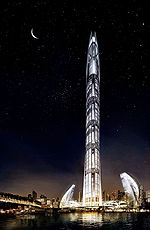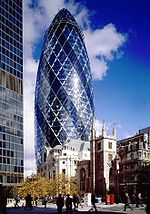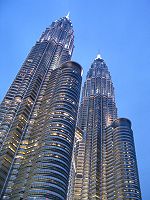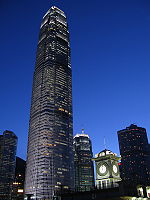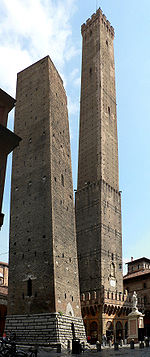Top Skyscrapers
History of Skyscraper
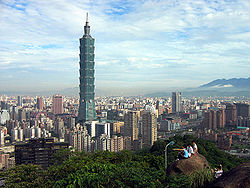
A skyscraper is a tall, continuously habitable building. There is no official definition or height above which a building may clearly be classified as a skyscraper. Most cities define the term empirically; even a building of 80 meters (262 feet) may be considered a skyscraper if it protrudes above its built environment and changes the overall skyline.
At the beginning of the 20th century, New York City was a center for the Beaux-Arts architectural movement, attracting the talents of such great architects as Stanford White and Carrere and Hastings. As better construction and engineering technology became available as the century progressed, New York and Chicago became the focal point of the competition for the tallest building in the world. Each city's striking skyline has been composed of numerous and varied skyscrapers, many of which are icons of 20th century architecture:
This geographical transition is accompanied by a change in approach to skyscraper design. For much of the twentieth century large buildings such as the Willis Tower and World Trade Center (New York) took the form of simple geometrical shapes. This reflected the "international style" or modernist philosophy shaped by Bauhaus architects early in the century. By the 1990s skyscraper design began to exhibit postmodernist influences. The newest record setters, though modern, incorporate traditional architectural features associated with the part of the world where they stand. Design of Petronas Twin Towers is based on the transformation of simple but elegant Islamic geometric principles, Taipei 101 recalls the traditions of Asian pagoda architecture even as the Burj Dubai incorporates motifs from traditional Arabic art, reflecting the cultural influences of their environment.
For current rankings of skyscrapers by height, see List of tallest buildings in the world.
The following list measures height of the roof. The more common gauge is the highest architectural detail; such ranking would have included Petronas Towers, built in 1998. See List of tallest buildings in the world for details.
Built Building City Country Roof Floors Pinnacle Current status 1873 Equitable Life Building New York United States 142 ft 43 m 8 Demolished 1889 Auditorium Building Chicago United States 269 ft 82 m 17 349 ft 106 m Standing 1890 New York World Building New York City United States 309 ft 94 m 20 349 ft 106 m Demolished 1894 Manhattan Life Insurance Building New York City United States 348 ft 106 m 18 Demolished 1899 Park Row Building New York City United States 391 ft 119 m 30 Standing 1901 Philadelphia City Hall Philadelphia United States 511 ft 155.8 m 9 548 ft 167 m Standing 1908 Singer Building New York City United States 612 ft 187 m 47 Demolished 1909 Met Life Tower New York City United States 700 ft 213 m 50 Standing 1913 Woolworth Building New York City United States 792 ft 241 m 57 Standing 1930 40 Wall Street New York City United States 70 927 ft 283 m Standing 1930 Chrysler Building New York City United States 925 ft 282 m 77 1,046 ft 319 m Standing 1931 Empire State Building New York City United States 1,250 ft 381 m 102 1,472 ft 449 m Standing 1972 World Trade Center (North tower) New York City United States 1,368 ft 417 m 110 1,727 ft 526.3 m Destroyed 1974 Willis Tower (formerly Sears Tower) Chicago United States 1,451 ft 442 m 108 1,729 ft 527 m Standing 2003 Taipei 101 Taipei City Taiwan 1,474 ft 448 m 101 1,671 ft 509 m Standing 2009 Burj Dubai Dubai United Arab Emirates 2,684 ft 818 m 162 2,684 ft 818 m Incomplete Source: emporis.com
Today An artist's rendering of 1 World Trade Center, currently under construction in New York. Nighttime rendition of Nakheel Tower. Today, skyscrapers are an increasingly common sight where land is scarce, as in the centres of big cities, because they provide such a high ratio of rentable floor space per unit area of land. But they are built not just for economy of space. Like temples and palaces of the past, skyscrapers are considered symbols of a city's economic power. Not only do they define the skyline, they help to define the city's identity.
supertall towers An interesting phenomena in the design of tall buildings has emerged recently in the Middle East, with new, extremely challenging proposals for supertall towers of heights exceeding one kilometer, such as Nakheel Tower[29], to be built in Dubai of the United Arab Emirates. With its announcement, the developer, Nakheel, intends to overtake the tallest structure in the world currently under construction in the same city of Dubai: the Burj Dubai. Other supertall towers are also proposed as new iconic buildings in the Middle East such as The Mile Tower to be built in Jeddah, KSA[30][31] and Burj Mubarak Al Kabir in Kuwait. These distinctively supertall towers are different from what have been normally identified as skyscrapers, as they create exceptional challenges and, arguably, represent a new architectural paradigm.[32]
Future skyscrapers The following skyscrapers are either approved or due to be completed in the near future:
At the beginning of the 20th century, New York City was a center for the Beaux-Arts architectural movement, attracting the talents of such great architects as Stanford White and Carrere and Hastings. As better construction and engineering technology became available as the century progressed, New York and Chicago became the focal point of the competition for the tallest building in the world. Each city's striking skyline has been composed of numerous and varied skyscrapers, many of which are icons of 20th century architecture:
- The Flatiron Building, standing 285 ft (87 m) high, was one of the tallest buildings in the city upon its completion in 1902, made possible by its steel skeleton. It was one of the first buildings designed with a steel framework, and to achieve this height with other construction methods of that time would have been very difficult.
- The Woolworth Building, a neo-Gothic "Cathedral of Commerce" overlooking City Hall, was designed by Cass Gilbert. At 792 feet (241 m), it became the world's tallest building upon its completion in 1913, an honor it retained until 1930, when it was overtaken by 40 Wall Street.
- That same year, the Chrysler Building took the lead as the tallest building in the world, scraping the sky at 1,046 feet (319 m).[26] Designed by William Van Alen, an art deco masterpiece with an exterior crafted of brick,[27] the Chrysler Building continues to be a favorite of New Yorkers to this day.[28]
- The Empire State Building, the first building to have more than 100 floors (it has 102), was completed the following year. It was designed by Shreve, Lamb and Harmon in the contemporary Art Deco style. The tower takes its name from the nickname of New York State. Upon its completion in 1931, it took the top spot as tallest building, and at 1,472 feet (448 m) to the very top of the antenna, towered above all other buildings until 1973.
- The World Trade Center was completed in 1973 and consisted of two tall towers and several smaller buildings. For a short time, the first of the two towers was the world's tallest building. Upon completion, the towers stood for twenty-eight years, until the September 11, 2001 attacks destroyed the structures. Various governmental entities, financial firms, and law firms called the towers home.
- The Willis Tower (formerly Sears Tower) was completed in 1974, one year after the World Trade Center, and surpassed it as the world's tallest building. It was the first building to employ the "bundled tube" structural system, designed by Fazlur Khan.[21] The building was not surpassed in height until the Petronas Towers were constructed in 1998, but remained the tallest in some categories until the Burj Dubai, currently under construction, surpassed it in all categories. It is currently the tallest building in the United States.
This geographical transition is accompanied by a change in approach to skyscraper design. For much of the twentieth century large buildings such as the Willis Tower and World Trade Center (New York) took the form of simple geometrical shapes. This reflected the "international style" or modernist philosophy shaped by Bauhaus architects early in the century. By the 1990s skyscraper design began to exhibit postmodernist influences. The newest record setters, though modern, incorporate traditional architectural features associated with the part of the world where they stand. Design of Petronas Twin Towers is based on the transformation of simple but elegant Islamic geometric principles, Taipei 101 recalls the traditions of Asian pagoda architecture even as the Burj Dubai incorporates motifs from traditional Arabic art, reflecting the cultural influences of their environment.
For current rankings of skyscrapers by height, see List of tallest buildings in the world.
The following list measures height of the roof. The more common gauge is the highest architectural detail; such ranking would have included Petronas Towers, built in 1998. See List of tallest buildings in the world for details.
Built Building City Country Roof Floors Pinnacle Current status 1873 Equitable Life Building New York United States 142 ft 43 m 8 Demolished 1889 Auditorium Building Chicago United States 269 ft 82 m 17 349 ft 106 m Standing 1890 New York World Building New York City United States 309 ft 94 m 20 349 ft 106 m Demolished 1894 Manhattan Life Insurance Building New York City United States 348 ft 106 m 18 Demolished 1899 Park Row Building New York City United States 391 ft 119 m 30 Standing 1901 Philadelphia City Hall Philadelphia United States 511 ft 155.8 m 9 548 ft 167 m Standing 1908 Singer Building New York City United States 612 ft 187 m 47 Demolished 1909 Met Life Tower New York City United States 700 ft 213 m 50 Standing 1913 Woolworth Building New York City United States 792 ft 241 m 57 Standing 1930 40 Wall Street New York City United States 70 927 ft 283 m Standing 1930 Chrysler Building New York City United States 925 ft 282 m 77 1,046 ft 319 m Standing 1931 Empire State Building New York City United States 1,250 ft 381 m 102 1,472 ft 449 m Standing 1972 World Trade Center (North tower) New York City United States 1,368 ft 417 m 110 1,727 ft 526.3 m Destroyed 1974 Willis Tower (formerly Sears Tower) Chicago United States 1,451 ft 442 m 108 1,729 ft 527 m Standing 2003 Taipei 101 Taipei City Taiwan 1,474 ft 448 m 101 1,671 ft 509 m Standing 2009 Burj Dubai Dubai United Arab Emirates 2,684 ft 818 m 162 2,684 ft 818 m Incomplete Source: emporis.com
Today An artist's rendering of 1 World Trade Center, currently under construction in New York. Nighttime rendition of Nakheel Tower. Today, skyscrapers are an increasingly common sight where land is scarce, as in the centres of big cities, because they provide such a high ratio of rentable floor space per unit area of land. But they are built not just for economy of space. Like temples and palaces of the past, skyscrapers are considered symbols of a city's economic power. Not only do they define the skyline, they help to define the city's identity.
supertall towers An interesting phenomena in the design of tall buildings has emerged recently in the Middle East, with new, extremely challenging proposals for supertall towers of heights exceeding one kilometer, such as Nakheel Tower[29], to be built in Dubai of the United Arab Emirates. With its announcement, the developer, Nakheel, intends to overtake the tallest structure in the world currently under construction in the same city of Dubai: the Burj Dubai. Other supertall towers are also proposed as new iconic buildings in the Middle East such as The Mile Tower to be built in Jeddah, KSA[30][31] and Burj Mubarak Al Kabir in Kuwait. These distinctively supertall towers are different from what have been normally identified as skyscrapers, as they create exceptional challenges and, arguably, represent a new architectural paradigm.[32]
Future skyscrapers The following skyscrapers are either approved or due to be completed in the near future:
- Construction of the Burj Dubai is underway in Dubai. Its exact height is 818 m (2,684 ft) high[33], making it the tallest building in the world. The Burj Dubai is due to be completed in September 2009.[34]
- Construction of the Pagcor Tower started in 2009, and when finished it will be the second tallest free-standing structure in the world with a height of 665 meters, it will be located in Manila bay near Mall of ASIA,by the project of PAGCOR.
- Construction of the Shanghai Tower started on 29 November 2008.[35] The tower will be 632 m (2,073 ft) high and have 127 floors.[36][37] The building will feature a glass curtain wall and nine indoor gardens when it is completed in 2014.[38][39]
- Construction has started for a 610 m (2,001 ft) skyscraper in Chicago, estimated to be completed in 2012[40]. The Chicago Spire, with 150 floors, will be the second tallest residential building in the world. Designed by Santiago Calatrava, it will also hold the title of North America's tallest free-standing structure.[41]
- 1 World Trade Center is now under construction and is the tallest tower comprising the redevelopment of the site of the former World Trade Center following the attacks of September 11, 2001.[42] Its antenna will reach a height of 541.4 m (1,776 ft),[42] a height representing the year of the United States Declaration of Independence.
- The Port Tower is a building planned for Karachi, the financial capital of Pakistan, with the collaboration of local and foreign investors, in association with the Karachi Port Trust. When completed, the new structure will be 1,947 ft (593 m) high. The height of the tower has a special significance, representing the year Pakistan gained independence.
- The 308 m (1,010 ft) Tour Generali in Paris La Défense, scheduled to be completed in 2013,[43] is an entirely green building office skyscraper that is set to be the tallest building in Paris and the second tallest in the European Union after the Shard of Glass in London.[43]
- Construction of the Shard London Bridge, also known as the Shard of Glass, started in March 2009, and is scheduled to be completed in May 2012, in time for the London Olympics.[44][45]. At 310 m (1,017 ft), it is set to be the tallest building in London, the United Kingdom and the tallest in the European Union.[46]
